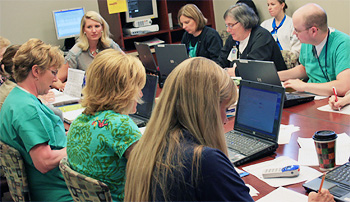 |
Dr. Ann Anderson-Berry conducts rounds with the NICU team. Before IntúaCare was created, the NICU team wrote their notes on paper, putting the original in the patient’s chart and giving a copy to the physician. Now they use their laptops to discuss a patient’s progress. |
They spent hours asking for input on how to make patient documentation more accurate and efficient.
All that research culminated at the end of February, when the NICU went live with its new software, IntúaCare, customized just for them.
It was Bud Shaw, M.D., along with software developer Hubert Hickman and their team of analysts and programmers who made it happen.
Dr. Shaw, former chairman of the department of surgery at UNMC, used a prototype of this software about five years ago with his liver transplant patients.
Now the medical director for ACAP (Advanced Clinical Applications Program), he and his 16-member team create custom software to treat specific groups of patients.
|
Clinicians are able to choose from a set of buttons and check boxes to record their observations and assessments.
As the data is recorded, the software builds in real time a detailed, accurate daily report for each patient.
“This was the other major goal of the software, to replace the bedside chart with more complete information and provide a more consistent picture,” Dr. Shaw said.
When a physician, resident, dietician or a nurse practitioner is finished with their daily report, they electronically sign it and it’s immediately uploaded into GE Centricity Enterprise, the hospital electronic health record system (also known as Carecast).
“Because of this software, we have better information to make clinical decisions,” said Ann Anderson-Berry, M.D., assistant professor of pediatrics at UNMC and a neonatologist at The Nebraska Medical Center. “It gives us real-time updates on a baby’s growth rate so if an infant is not meeting his or her growth requirements we’re able to take corrective action faster.”